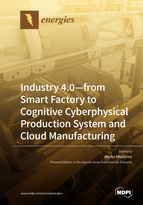Industry 4.0—from Smart Factory to Cognitive Cyberphysical Production System and Cloud Manufacturing
A special issue of Energies (ISSN 1996-1073). This special issue belongs to the section "F: Electrical Engineering".
Deadline for manuscript submissions: closed (30 June 2022) | Viewed by 21606
Special Issue Editor
Interests: production systems; production networks; cyberphysical production systems; multicriteria decision making; multi-objective optimization; Industry 4.0
Special Issue Information
Dear Colleagues,
It has been more than five years since the Industry 4.0 paradigm became a global research trend. From the beginning, it was clear that the Smart Factory concept would be its main enabler. Smart Factory was seen as a place where virtual and reality meet, supported by the Industrial Internet of Things and Cyberphysical Production System. However, it soon became clear that we need to take a step forward in our production cyberspace, toward a cognitive system. This is something that goes beyond the concept of smart, something more than big data analytics. A cognitive system can learn and adapt to new situations and to new market demands, completely autonomously or with some human support. A cognitive cyberphysical production system requires brand-new cognitive algorithms and decision-making systems.
Generally, the backend of such a system is a cloud-based information system known as cloud manufacturing. The design of such an information system, networked with ERP and MES, is a challenging task. Nevertheless, with a cognitive cyberphysical production system, new business models for the new era of personalized production become possible: manufacturing-as-a-service and production-as-a-service. Since they go beyond single enterprises and toward the networking of enterprises, they lead to new organizational models and platforms: production networks and social manufacturing. However, cognitive systems also raise some ethical issues, which is not common for production research problems. These ethical issues are their transparency, inclusion, responsibility, impartiality, reliability, security, and privacy. They represent an important research topic, especially to distinguish Industry 4.0 research from transhumanism ideas.
As a response to all these challenges, we have launched this Special Issue of the journal Energies on the topic of “Industry 4.0—from Smart Factory to Cognitive Cyberphysical Production System and Cloud Manufacturing”.
I invite you to submit your paper to this Special Issue and share your research with us and with the academic community. Potential topics include but are not limited to smart factory concepts and demonstrators, cyberphysical production system models and prototypes, cognitive systems applied to the manufacturing domain, cognitive algorithms and decision-making systems, applications of the Industrial Internet of Things, production network models and solutions, manufacturing-as-a-service and production-as-a-service platforms, cloud manufacturing models and demonstrators, and ethical issues regarding cognitive systems. In addition to research papers, review papers are welcomed as well.
Prof. Dr. Marko Mladineo
Guest Editor
Manuscript Submission Information
Manuscripts should be submitted online at www.mdpi.com by registering and logging in to this website. Once you are registered, click here to go to the submission form. Manuscripts can be submitted until the deadline. All submissions that pass pre-check are peer-reviewed. Accepted papers will be published continuously in the journal (as soon as accepted) and will be listed together on the special issue website. Research articles, review articles as well as short communications are invited. For planned papers, a title and short abstract (about 100 words) can be sent to the Editorial Office for announcement on this website.
Submitted manuscripts should not have been published previously, nor be under consideration for publication elsewhere (except conference proceedings papers). All manuscripts are thoroughly refereed through a single-blind peer-review process. A guide for authors and other relevant information for submission of manuscripts is available on the Instructions for Authors page. Energies is an international peer-reviewed open access semimonthly journal published by MDPI.
Please visit the Instructions for Authors page before submitting a manuscript. The Article Processing Charge (APC) for publication in this open access journal is 2600 CHF (Swiss Francs). Submitted papers should be well formatted and use good English. Authors may use MDPI's English editing service prior to publication or during author revisions.
Keywords
- Industry 4.0
- Cyberphysical production system
- Smart factory
- Cognitive system
- Production network
- Social manufacturing
- Industrial Internet of Things
- Cloud manufacturing
- Key enabling technologies
- Manufacturing-as-a-service






